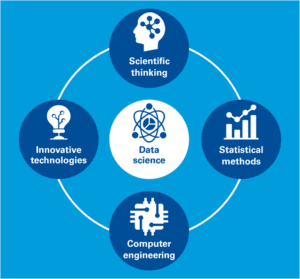When we are working with more than two classes in data, LDA or Linear Discriminant Analysis is the best classification technique we can use. This model provides very important benefits to data mining, data retrieval, analytics, and Data Science in general such as the reduction of variables in a multi-dimensional dataset.
This is very useful for minimizing the variance between the means of the classes while maximizing the distances between the same. LDA removes excess variables while retaining most of the necessary data. This is extremely crucial for Applied Machine learning and various Data Science applications such as complex predictive systems.
What is Linear Discriminant Analysis?
LDA is a linear classification technique that allows us to fundamentally reduce the dimensions inside a dataset while also retaining most of the crucial data and utilizing important information from each of the classes. Multi-dimensional data contains multiple features that have a correlation with other features. Using dimensionality reduction, one can easily plot multidimensional data into two or three dimensions.
This also helps make data more cognizable for non-technical team members while still being highly informative (with more relevant details). LDA estimates the probabilities of new sets of inputs belonging to each class and then makes predictions accordingly.
Classes with the highest probability of having new sets of inputs are identified as the output class for making these predictions. The LDA model uses Bayes Theorem for estimating these probabilities from classes and data belonging to these classes.
LDA allows unnecessary features that are “dependent”, to be removed from the dataset when converting the dataset and reducing its dimensions. LDA is also very closely related to regression analysis and analysis of variance. This is due to all of their core objectives of trying to express individual dependent variables as linear combinations of other measurements or features.
However, Linear Discriminant Analysis uses a categorical dependent variable and continuous independent variables. Unlike different regression methods and other classification methods, LDA assumes that independent variables are distributed normally. For example, logistic regression is only useful when working with classification problems that have two classes.
How is LDA used in Python?
Using LDA is quite easy, it uses statistical properties that are predicted from the given data using various distribution methods such as multivariate Gaussian (when there are multiple variables). Then these statistical properties are used by the LDA model for making predictions. In order to effectively use the LDA model or to use Python for Data Science, one must first employ various libraries such as pandas, matplotlib, and numpy.
First, you must import a dataset such as the ones available in the UCI Machine Learning repository. You can also use scikit-learn to import a library more easily. Then, a data frame must be created that contains both the classes and the features.
Once that is done, the LDA model can be put into action, which will compute and calculate within the classes and class scatter matrices. Then, new matrixes will be created and new features will be collected. This is how a successful LDA model can be run in Python to obtain LDA components.
Conclusion
Linear Discriminant Analysis is one of the most simple and effective methods for classification and due to it being so preferred, there were many variations such as Quadratic Discriminant Analysis, Flexible Discriminant Analysis, Regularized Discriminant Analysis, and Multiple Discriminant Analysis. However, these are all known as LDA now. In order to learn Python for Data Science, a reputed PG Analytics program is recommended.




 With an industry-designed curriculum, you can learn about the use cases of data science in the logistics industry. From
With an industry-designed curriculum, you can learn about the use cases of data science in the logistics industry. From 
 The demand for
The demand for 


 Future outlook:-
Future outlook:-
 An enormous amount of data is managed through computing power to make it possible. A
An enormous amount of data is managed through computing power to make it possible. A 
 However, one thing to be concerned about is that it is going to make the already competitive industry even more neck and neck. The first preference for positions is going to be data scientists with experience, and then freshers with a high level of skills.
However, one thing to be concerned about is that it is going to make the already competitive industry even more neck and neck. The first preference for positions is going to be data scientists with experience, and then freshers with a high level of skills.